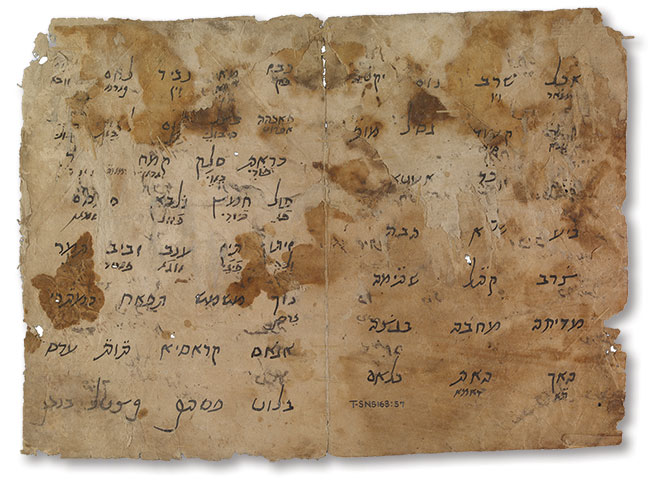Strange, I’ve Seen that Face Before
One day when we were both in Cambridge working on documents from the Cairo Geniza, Amir Ashur asked me what I thought about a difficult sentence in a medieval Judeo-Arabic letter. I turned from what I was doing and suddenly found myself once again in the private world of an unknown Andalusi Jew. It was just as María Ángeles Gallego had said to me decades ago when she introduced me to that huge, amazing, haphazard archive from the Ben Ezra Synagogue in Old Cairo: “it is the intimate moment when you are really there with the Andalusis.”
Eventually, Amir and I decided to collect several of these personal letters from the geniza and publish them under the title La vida cotidiana de los judíos de Alandalús (The Daily Life of the Jews of Alandalús). Unlike my earlier work on figures such as the great tenth-century Hebrew grammarian from Cordova Judah Hayyuj, this was a book my friends and family could enjoy. Amir and I were approached to do an English version, but we wanted to write something new, rather than simply produce a translation.
While we were going over materials for the new book, I reviewed a geniza fragment held in the Cambridge collection (T-S NS 163.57). I had the fragment listed in my notes as a small glossary, translating some Judeo-Arabic terms into a medieval Romance language. Just as I was about to close the window and move on to the next text, two words, fustaq (pistachio) and qastal (chestnut), winked at me from the bottom corner of the fragment as if I were a friend. It was like the old Grace Jones song: “Strange, I’ve seen that face before.”

I recognized the handwriting but I couldn’t quite believe who was winking at me through the window. I checked the bibliographic records of the fragment on the Friedberg Genizah Project website and went over its publication history: nothing. I began to doubt myself. So I emailed Amir and, without saying any more, asked him if the handwriting looked Andalusi to him. He wrote back—“The truth is . . . I would have said that it was Maimonides’ handwriting”—and I knew that I wasn’t crazy.
Another utterly remarkable thing about the geniza is that it includes about sixty autographic fragments from Maimonides, many of them with his own signature. We have now matched the handwriting in this little glossary to the same words in some of those fragments that are indubitably from Maimonides’s own hand. The paper used is also the same size and type as that used in drafts of parts of his great halakhic code Mishneh Torah and other works.
Colleagues with whom we have consulted agree: this modest vocabulary list with terms for colors, flavors, foods, and simple actions and feelings was without a doubt written by the great philosopher, jurist, physician, and community leader Moses Maimonides. It is the only instance we have of him writing in a Romance language.
I was born in Cordova and grew up there, playing in the narrow streets and squares of its medina, in its gardens and alcazars, its synagogue and the Aljama Mosque. I always felt the greatness of that lost Muslim and Jewish Arabic culture strongly, and I wanted to know more about the people who built my playground.
Thanks to my parents, I was lucky enough to study Hebrew and Arabic in Madrid at the Complutense University when I was still a teenager. I was taught by wonderful professors and received an exquisite training in classical Hebrew. As the courses progressed, medieval Hebrew arrived. Eventually, I became a student of Professor Ángel Sáenz-Badillos (1940–2013), the author of a landmark history of the Hebrew language and a teacher of warmth and genius. When I arrived at the Hebrew University, I quickly became a Hebrew speaker thanks to the training I had in Madrid.
My life as a Spanish scholar of Hebrew and Arabic studying medieval Hebrew and Arabic—and above all Judeo-Arabic—literature has been truly blessed. From the support of the University of Granada to my earlier fortunate finds (an unknown poem of the great eleventh-century Solomon ibn Gabirol, fragments of a book on Hebrew metrics that made me rethink everything I thought I knew about the Hebrew poetry of medieval Spain) to the extraordinarily collegial Genizah Research Unit of the University of Cambridge, where I find myself this year, I cannot have asked for a more fulfilling scholarly life.
What was Maimonides doing in making this little vocabulary list of colors, flavors and smells, actions, and foods? The terms aren’t arranged in alphabetical order but rather with a kind of intuitive or associative logic. In listing colors, Maimonides begins with black and white, moves on to primary colors and then to derivative ones (vinous, or wine colored), before proceeding to flavors and aromas. In doing so, he moves from sight to taste to smell. His list of foods proceeds from bread and water to vegetables, to edible seeds (wheat, chickpea), to seeded fruits (olive, fig), to dried fruits and nuts (acorn, pistachio), to foods from other natural products (milk, honey). The list of actions first describes the basic actions (eat, sleep) and then moves on to more complex actions, feelings, and emotions.
But exactly which Romance language was Maimonides translating—or attempting to translate (not all the words are translated)—his Judeo-Arabic into? In principle it should have been the Andalusi Romance language since he grew up in Cordova and the words are all simple domestic terms he would have heard as a child (though by the time he wrote these lists as an adult in Cairo, Andalusi had already begun to die). But was it Andalusi?
Amir and I turned to our friend Alberto Montaner Frutos from the University of Zaragoza who specializes in the Romance language of the Iberian Peninsula during Maimonides’s time. Alberto confirmed that many of the words are Andalusi, or could be (since then, as now, there was overlap between Romance languages). But there is also a puzzle. The plurals should take an /s/ as in present-day Spanish. But in Maimonides’s list, where the singular has /a/, its plural is /e/, and where it has /o/, its plural is /i/, as in present-day Italian (and southern Italian Romance variants of the time). Why? The truth is that I have no idea. Any specialist in language acquisition (or parent) knows that the first thing children learn after a simple vocabulary is the number inflection. I don’t know anyone who pluralizes Spanish words as if they were Italian, unless they are playing around. And perhaps Maimonides was just playing around. I simply don’t know what he was doing.
However, I do think that we are seeing the writing of an idle Maimonides for the first time. This is not philosophy, medicine, law, or important correspondence. He is not thinking about the nature of God or the world or the welfare of his community; he is tinkering in a language we did not think he knew—and still do not know how well he knew.
Suggested Reading

A Maimonides in Monsey
Maimonides’s only son, Abraham, fought to protect his father’s rationalist legacy. Now a direct descendant has republished his works, and a new Maimonidean controversy is percolating in “yeshivish” circles.
Thoroughly Modern Maimonides?: A Rejoinder
To sharpen Stern’s point, we may say that the person who believes God literally gets angry metaphorically angers God.
Maimonides in Ma’ale Adumim
Rabbi Nachum Rabinovitch has been working on his commentary to the Mishneh Torah for the last 41 years. It may be the greatest rabbinic work of the century.

Buried Treasure
Hundreds of thousands of Jewish manuscripts were redeemed from Egypt.
Comments
You must log in to comment Log In